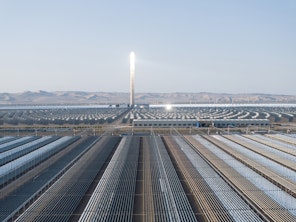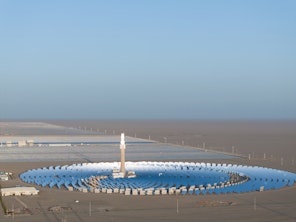
Massive concentrated solar power (CSP) plants stand guard over desert regions from China and Chile to South Africa and Spain.
These vast structures, where acres of mirrors silently gather the sun’s heat and store it in molten salt, can provide a welcome respite to the intermittency that other renewable power sources can bring to the electricity grid.
Unlike photovoltaic solar or wind energy, CSP’s molten salt thermal storage can power steam turbines at will, helping to stabilize the electric system or providing energy at night when other types of low-carbon generation are not available. That, at least, is how most CSP is used today.
But CSP has another potential use that could be just as valuable, if not more. When the heat from molten salt drives a turbine to make electricity, energy is naturally lost in the process. But what if the heat could be used directly?
For many industrial applications, access to heat is just as important as access to electricity. Heat represents 74% of global industrial energy demand, which in turn accounts for 30% of worldwide power consumption, according to figures from the International Energy Agency.
Half of this heat is at temperatures below 400ºC, which is well within the range that can be served by CSP. And 90% of today’s industrial heat demand is met through fossil fuels, which poses problems for industrial concerns on two fronts.
The first is environmental: like other sectors, industry faces calls to reduce its carbon footprint. Industrial processes account for about a quarter of global carbon emissions, and there is intense regulatory and stakeholder pressure to reduce this amount.
Hence, many industrial sectors have committed to cutting their greenhouse gas emissions to zero, which will be hard to do with fossil fuels unless they make significant investments in technologies such as carbon capture and storage.
The second issue is cost: the war in Ukraine has driven oil and gas prices to stratospheric levels and even if they eventually level out there is no guarantee pricing will not go up again in future.
What can industrial heat users do to avoid carbon levies?
A growing number of markets are also requiring industrial concerns to pay carbon levies, further increasing the cost of using fossil fuels. What can industrial heat users do to avoid this? There are several low-carbon alternatives to fossil fuels, although most of them have drawbacks.
One is to use electric heat pumps. This is a tried-and-tested, low-cost technology that can be deployed at scale, but its heat potential is limited to a maximum of around 160ºC, restricting the range of applications it can be used for.
Another is bioenergy, for instance using biogas in place of natural gas. Here the problem is that sources of bioenergy are limited and there is high demand for biofuels from other sectors, such as aviation, which could drive up costs.
A third option is to use renewable electricity for heating, for example to power electric arc furnaces in foundries. While clearly an option for steelmaking, in other areas renewable energy supplies could suffer from intermittency and the loss of efficiency involved in turning electricity into heat.
Fourth, one much-vaunted future energy option is low-carbon hydrogen. In practice, green hydrogen made using renewable electricity will have even greater efficiency losses than using the electricity directly, and like biogas green hydrogen will be sought after for a wide range of other applications.
Finally, one day it might be possible to get large amounts of cheap industrial heat from emerging technologies such as advanced geothermal plants or small modular nuclear reactors. These concepts have lots of promise but for now they are just that—concepts.

On reflection, all these low-carbon heat options would have to work hard to achieve something that CSP can do easily today, in sunny climates at least.
The list of industries that rely mostly of heat at temperatures up to 400ºC is long and includes food, beverages, tobacco, textiles, leather, transport equipment, mining, quarrying, paper, pulp, printing, machinery, wood production and construction.
Delivering industrial process heat
CSP already has a significant track record in the delivery of industrial process heat. CSP plants have been used for the petrochemical industry in the US and the Middle East, sludge treatment and pulping in Canada, and textiles in Spain, to name just a few examples.
Also in Spain, work is starting on a 30 MW CSP plant for heat production for the beverages giant Heineken. The plant is expected to cut Heineken’s natural gas use by more than 60%. Elsewhere, there are major opportunities to deploy CSP across a range of other industries.
One of the biggest of these is in mining and minerals extraction, where companies not only have a massive need for process heat but also typically have operations in remote locations where there is ample space for CSP plant development.
According to the University of Adelaide in Australia, in mining CSP has “strong potential to compete with natural gas.”
It adds: “Direct solar heat for mineral processing can also be used for steam production for ore concentration, hot air for drying, and solar thermal for crushing and grinding rocks, a massive energy demand in Australia and globally.
“Solar thermal can also be used to produce chemicals for industrial processes, such as producing sulfuric acid for use in concentrate leach and tails leach for copper.”
These industries can all be served using parabolic trough CSP, which is the most established, lowest-cost version of concentrated solar. Parabolic trough plants have stood the test of time, with one unit in the US that was commissioned in 1990 still in operation today.
It is also a technology that we know well at Pacific Green, having developed a 50 MW reference plant in China. Our team has worked on parabolic trough projects around the world.
We have been active in this industry for more than a decade and can provide complete turnkey CSP developments with proven performance on time, on budget, and to the latest specification.
Hence, if you are looking to obtain low-cost, low-carbon, round-the-clock heat for your industrial processes, contact us now.
Publish date: 18 March, 2024